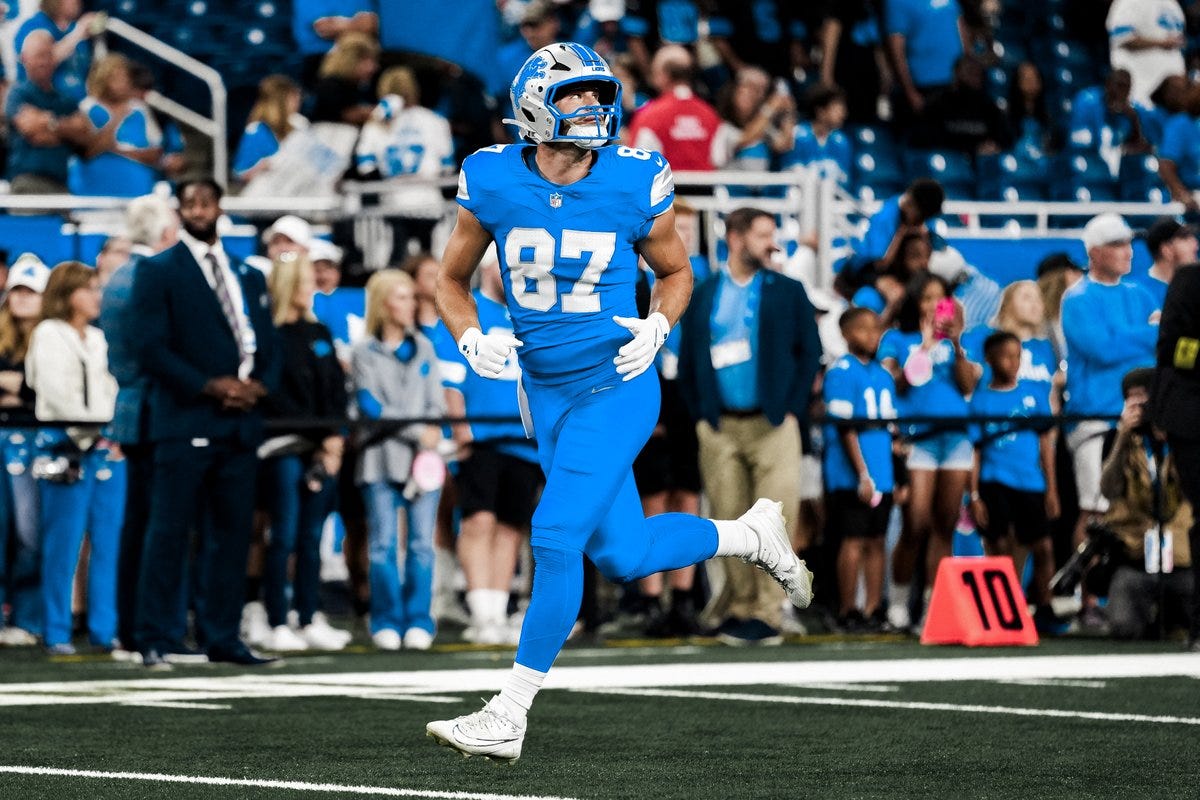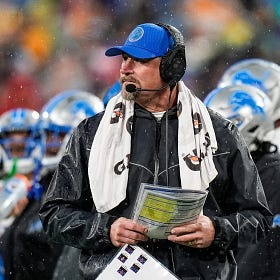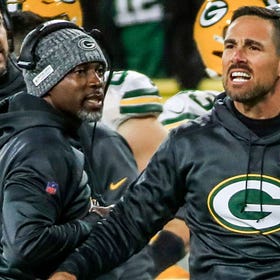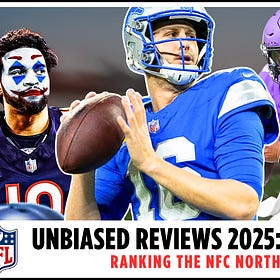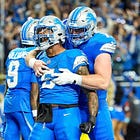NFL Week 12: Detroit Lions Offensive & Defensive Keys Vs NY Giants
Do not sleep on the Giants. When their defensive line clicks, it's violent and dangerous
The Giants (2-9) head to Detroit this Sunday looking to snap their 5-game losing skid against a Detroit Lions team sitting at 6-4 facing a lot of questions about the possibilities for this 2025 team.
This matchup marks the third stop for the New York Giants NFC North tour, with the final matchup vs the Vikings Week 16.
Detroit enters Week 12 frustrated from a 16-9 loss in Philadelphia—their lowest-scoring output of the season and the first time they’ve been held to single digits since Week 7 of 2023. The loss dropped the Lions outside the NFC playoff picture, temporarily, adding urgency to this 3-game home stand.
The New York Giants are battered and struggling. The Giants’ defense ranks near the bottom of the league in nearly every major category. They are 29th in points allowed (27.3 per game), 31st in total yards allowed (375.1 per game), and 30th in rushing defense (149.9 yards per game).
Injuries to key defenders like Kayvon Thibodeaux (shoulder, out) and Paulson Adebo (knee, out) further strip their pass rush and secondary depth. This context makes Detroit’s offensive blueprint — protection, mismatches, vertical shots, and run balance — not just logical, but highly effective.
Biggest Worry: Giants Defensive Front
When The Giants’ Defensive Front Fires On All Cylinders
The New York Giants may be struggling in the standings, but their defensive front remains one of the most dangerous units in football when it plays to its potential. Anchored by Dexter Lawrence, the interior is a fortress — his sheer size and strength collapse pockets and clog running lanes, forcing offenses to adjust protections.
On the edge, Brian Burns is the NFL’s sack leader, a relentless pass rusher with elite bend and closing speed. If Burns wins early, quarterbacks rarely escape. Complimenting him is Abdul Carter, whose athleticism and motor provide a disruptive presence opposite Burns, ensuring offenses can’t simply slide protection one way.
Behind them, Bobby Okereke is the heartbeat of the second level. His range and tackling volume allow the Giants to disguise blitzes and close gaps quickly. Adding to the mix is rookie Darius Alexander, a promising young defender whose explosiveness and versatility give New York another weapon in sub-packages.
Do not sleep on the Giants. When their defensive line clicks, it’s violent and dangerous. Lawrence collapsing the middle, Burns and Carter crashing off the edge, Okereke cleaning up, and Alexander flashing in rotation — the Giants can dictate tempo, force turnovers, and suffocate opposing offenses. It’s a front built to wreck game plans, and if they find rhythm, few lines in the league can withstand the pressure.
Giants Defensive Vulnerabilities
Run defense collapse
Season: 5.5 YPC (32nd), -0.14 EPA/rush (32nd).
Weeks 7–11: 6.0 YPC, 14.8% explosive run rate.
Missing McFadden, Dexter Lawrence’s stop rate plummeted (11.9% to 5.7%).
Tackling issues
22.8% avoided-tackle rate (bottom tier).
DBs reluctant in run support → Gibbs/Montgomery can turn arm tackles into chunk gains.
Coverage strain
Heavy man usage (39.3%) but middling results: 44% success rate allowed.
Quick pressures exist, but discipline breaks down on YAC.
Matchup Pivots
Detroit OL vs Giants DL
Fraley’s group must climb to 2nd level and reset tone with gap concepts.
Sewell can dictate tempo if allowed to maul.
Goff vs Blitz
Giants gamble on 2nd down → Lions must punish with rhythm throws.
Complement run success with vertical shots to Williams.
Giants OL vs Lions Pass Rush
Improved unit (36.7% pressure rate, 17th) gives Winston a chance.
Hutchinson/McNeill must win early downs to force Winston into mistakes.
Key 1: Neutralize Brian Burns & The Giants’ Edge Pressure
Why This Scheme Matters
Brian Burns has been nothing short of dominant in 2025. He leads the Giants and is tied for the NFL lead with 13 sacks through 11 games, including multiple multi-sack performances. His pressure rate and pass-rush win rate are among the highest in the league, forcing offensive coordinators to slide protections his way or keep extra blockers in. Burns wins with a rare combination of speed, bend, and improved power moves, consistently collapsing pockets and setting the edge against the run.
Detroit cannot treat Burns like any other rusher — he is a game-wrecker. The Lions’ tackles, Taylor Decker and Penei Sewell, must anchor against his speed rush while staying disciplined against inside counters. Burns’ ability to force hurried throws is especially dangerous given the Giants’ otherwise porous defense; he is the one player who can flip momentum on his own.
Techniques & Scheme Adjustments
Slide Protections: Shift the line toward Burns to ensure he is doubled or chipped.
RB/TE Help: Use Montgomery or Gibbs to chip Burns before releasing, and deploy tight ends in max protect sets.
Quick Game: Incorporate slants, hitches, and RPOs to get the ball out before Burns can win his rush.
Play-Action Discipline: Fake runs to slow Burns’ first step, then attack zones vacated by blitzes.
Why It Works Against the Giants
The Giants rank 31st in total defense (375.1 yards per game) and 29th in points allowed (27.3 per game). Outside of Burns, their pass rush is inconsistent — Kayvon Thibodeaux (shoulder, out) has just 2.5 sacks, and rookie Abdul Carter has only 0.5. This means Detroit can focus resources on Burns without fearing a balanced rush.
Additionally, the Giants’ secondary is depleted (Paulson Adebo out, Deonte Banks questionable), leaving them vulnerable if Goff has time. Neutralizing Burns removes their only elite defensive weapon and exposes the rest of the unit.
Supporting Stats
Brian Burns: 13 sacks, 52 tackles, 2 forced fumbles, 7 passes defended.
Giants Defense:
31st in yards allowed (375.1/game)
29th in points allowed (27.3/game)
30th in rushing defense (149.9/game)
Injuries: Thibodeaux (shoulder, out), Adebo (knee, out), Banks (hip, questionable), Nubin (neck, questionable)
Key 2: Exploit Linebacker Coverage Gaps
New York’s linebackers, led by Bobby Okereke, are aggressive downhill defenders who rack up tackles but continue to struggle in coverage getting exposed in space. The Giants’ have allowed 19 passing touchdowns through the air (bottom third of the NFL), against tight ends, running backs, and receivers in the passing game. Highlighting their struggles in coverage and red-zone pass defense.
Normally, the Lions would lean heavily on Sam LaPorta to exploit these mismatches — his option routes, reliable blocking, and ability to serve as Jared Goff’s safety valve have been central to Detroit’s offensive identity. However, with LaPorta sidelined for 4–6 weeks and possibly the season, they must manufacture his production somehow.
The responsibility now shifts to Brock Wright, who provides solid inline blocking and short-area reliability. Wright’s ability to hold up against edge defenders is critical to maintaining run balance. Then there is Isaac Teslaa, finding an opportunity with an expanded role in the passing game. Teslaa can produce some of LaPorta’s production up the seams and over the middle, with his size and catch radius able to stress linebackers and safeties in coverage. This gives Goff another weapon to attack the middle of the field.
Let’s not forget about Jahmyr Gibbs here either. The Lions offensive plan should include sending Gibbs into the slot more often, using his speed and versatility to pull the defense away from Jared Goff giving Goff more time to work. With David Montgomery filling the run duties the Lions can take advantage of mismatches all afternoon.
Scheming these players into favorable situations — using motion, bunch formations, and RPO looks to force linebackers into space and expose their tackling inefficiency.
Why This Scheme Works
The Giants rank near the bottom of the league in tackling efficiency, averaging 6.5 missed tackles per game (27th). Okereke leads the team in tackles but carries a 12% missed tackle rate, leaving exploitable gaps when forced into coverage. By rotating Wright into blocking-heavy sets and flexing Teslaa into intermediate routes, Detroit can continue to stress New York’s linebackers even without LaPorta.
Techniques & Scheme Adjustments
Brock Wright: Inline blocking to neutralize edge rushers, short curls and seam routes to keep chains moving.
Isaac Teslaa: Flexed wide or in the slot to attack linebackers and safeties with size mismatches.
Motion & RPOs: Force linebackers to declare coverage and open lanes for backs like Gibbs.
Supporting Stats
Giants allow 7.1 yards per target to tight ends (bottom 10 in NFL).
Giants rank 27th in missed tackles (6.5 per game).
Okereke leads the team in tackles but has a 12% missed tackle rate.
LaPorta averaged 2.4 yards per route run vs. linebackers before injury.
Key 3: Attack Vertically Often
The Giants’ secondary is depleted: Paulson Adebo (knee) is out, Deonte Banks (hip) is questionable, and their depth has been stretched thin all season. They allow 225.2 passing yards per game (22nd) and rank 32nd in red-zone defense (73.7% TD rate), making them vulnerable to explosive plays and quick strikes.
With LaPorta sidelined, the Lions must lean more heavily on their wide receivers to stretch the field. This means Jameson Williams, Amon-Ra St. Brown, and emerging contributors like Isaac Teslaa will be central to pushing the ball downfield. By attacking vertically, Detroit can keep the Giants’ defense from crowding the box, force safeties to cover more ground, and establish rhythm and tempo that leads to quick scoring drives.
Why This Scheme Works
The Giants have surrendered 35 total touchdowns on the season (29th) and give up explosive plays on 11% of passes. Their safeties are prone to biting on play-action, and without LaPorta occupying the middle, Detroit can deploy more receivers in vertical sets to stretch coverage. Quick strikes up top prevent the Giants from blitzing freely and allow the Lions to dictate pace, pushing the ball into the end zone often.
Techniques & Scheme Adjustments
Stutter-go and double moves vs. press coverage to exploit aggressive corners.
Slot fades against single-high looks to stress safeties.
Max protect formations to give Goff time for deep shots.
Tempo-driven vertical sets to keep the defense on its heels and prevent substitutions.
Supporting Stats
Giants surrendered explosive plays (20+ yards) on 11% of passes.
Jameson Williams averaged 18.7 yards per catch entering Week 12.
Giants rank 32nd in red-zone defense (73.7% TD rate).
Key 4: Establish Run Balance Against a Vulnerable Front
Detroit’s offense thrives when the run game sets up play-action, and this week presents a prime opportunity. The Giants’ front, while featuring stars like Dexter Lawrence and linebacker Bobby Okereke, has been one of the league’s worst against the run.
The Lions must lean into duo and inside zone concepts to test gap integrity, while counters and power runs punish over-pursuit. Pre-snap motion widens defensive fronts and creates leverage for backs, giving David Montgomery and Jahmyr Gibbs room to operate. Even modest rushing success forces the Giants’ linebackers to hesitate, preventing them from pinning their ears back and dictating tempo.
Why This Scheme Works
The Giants rank near the bottom of the NFL in run defense, allowing 149.9 rushing yards per game (30th) and 15 rushing touchdowns (31st). Their tackling inefficiency — a 27th-ranked missed tackle rate (6.5 per game) — compounds the problem. With Lawrence struggling to replicate his 2023 stop rate and Okereke missing tackles at a 12% clip, Detroit can consistently move the chains and set up play-action strikes.
Techniques & Scheme Adjustments
Duo and inside zone runs to test gap integrity.
Counters and power runs to exploit over-pursuit.
Motion and varied personnel to widen fronts and create leverage.
Supporting Stats
Giants allow 4.3 yards per carry (Weeks 1–11).
Giants rank 30th in rushing defense (149.9 yards/game).
David Montgomery averages 3.2 yards after contact per attempt.
Jahmyr Gibbs averages 5.2 yards per carry (6th in NFL).
Players to Watch: Giants
🔹RB Tyrone Tracy Jr.
Tracy is heating up. The second-year back just posted a season-best 139 scrimmage yards against Green Bay, carving up the Packers for 88 rushing yards on 19 carries (4.6 YPC) and adding 51 more through the air on four catches.
That performance followed a strong Week 10 showing against Chicago, where Tracy averaged 5.1 yards per carry on 14 totes. Through nine games (five starts), he’s totaled 336 rushing yards (4.0 YPC) and 138 receiving yards on 18 catches.
But Sunday’s test won’t be easy. Detroit ranks 8th in rushing yards allowed and 11th in yards per carry. Only four teams have cracked 100 yards on the ground against them—and three of those came in the last five weeks. Through the air, they’ve been even stingier: the Lions have allowed just 204 receiving yards to running backs all season, the fewest in the NFL.
🔹 WR Isaiah Hodgins
Just three days after being signed off the Steelers’ practice squad, Isaiah Hodgins was thrust into the Giants’ starting lineup—and delivered. Filling in for the injured Darius Slayton, Hodgins led the team in receiving against Green Bay, hauling in 5 of 6 targets for 57 yards in his season debut.
It was a strong return for a player who’s flashed before. Hodgins played in three games for the Giants last year and was active all of 2023, but his breakout came in late 2022 after being claimed off waivers from Buffalo. In just eight games to close that season, he posted 33 catches for 351 yards and four touchdowns—then exploded for 105 yards and a score in the Wild Card win over Minnesota.
He’ll face a Lions secondary that’s been vulnerable in the red zone. While Detroit ranks 8th in passing yards allowed, they’ve given up 18 passing touchdowns—tied for 24th in the league. Thirteen of those have gone to wide receivers, the fourth-most in the NFL. And injuries are piling up: CB Terrion Arnold (concussion) and S Kerby Joseph (knee) missed Wednesday’s practice, while CB D.J. Reed remains on IR but returned in limited fashion this week.
🔹 LT Andrew Thomas & RT Jermaine Eluemunor
The Giants’ bookend tackles held their own last week against a fierce Packers front. Andrew Thomas and Jermaine Eluemunor each allowed one sack, but combined for just four total pressures—only the second time all season they’ve hit that number.
Together, they’ve formed the most reliable tackle duo New York has had in years. Thomas enters Week 12 ranked 5th among all tackles in pass protection by PFF, with Eluemunor not far behind at No. 16. Both have allowed more than one pressure in just two games apiece. Thomas also leads all left tackles in average time to pressure allowed at 4.03 seconds, per Next Gen Stats.
But Detroit brings heat. The Lions’ pass rush is anchored by Aidan Hutchinson, who’s back in form after a 2024 leg injury derailed a DPOY-caliber start. He leads the NFL with 57 pressures and is tied for the league lead with four forced fumbles. Hutchinson moves across the line, so both Thomas and Eluemunor will see him throughout the game.
When Hutchinson isn’t crashing the edge, the Giants’ tackles will have to deal with Al-Quadin Muhammad, who ranks second on the team with six sacks and 12 QB hits.
Breakdown: How Lions Defense Can Defeat Giants Offense
The Detroit Lions’ defense (5th in total defense, 10th in scoring defense) has a clear path to victory against a New York Giants offense that ranks 15th in total offense but just 23rd in scoring. With Jameis Winston starting at quarterback and the Giants dealing with injuries across their skill positions, Detroit’s strategy must focus on three pillars: shutting down the run, exploiting protection issues in the passing game, and clamping down on short/intermediate routes to force turnovers.
Key 1: Shut Down the Giants’ Run Game
The Giants’ most reliable offensive weapon remains their ground attack, ranking 10th in the NFL in rushing yards per game. If Detroit can neutralize this, they’ll force Winston into obvious passing downs — a scenario that favors the Lions’ pass rush.
Why it works: The Lions are 8th in the NFL against the run (99.7 yards/game) and lead the league in stuffing 3rd-and-short runs (59%). With Aidan Hutchinson & Al-Quadin Muhammad setting the edge, Alim McNeill, Williams & Reader controlling the interior, Detroit can maintain gap discipline and force negative plays. The Lions linebackers have been absolute nightmares for teams trying to run anything through the middle.
Keeping the Giants under 100 rushing yards will put the game squarely on Winston’s arm, where mistakes & turnovers are more likely. I can see the Lions popping a fumble in this game with how disciplined they have been at attacking the football.
Run Defense Identity:
Gap discipline
Stack boxes on early downs
Limit explosive runs to keep tempo in Detroit’s favor
Supporting Stats:
Giants rank 10th in rushing offense but just 23rd in scoring.
Lions allow only 3.9 yards per carry (top 10).
Key 2: Exploit Pressure & the Giants’ Struggling Pass Game
The Giants’ passing offense is middling and turnover-prone, and with Jameis Winston starting, Detroit should lean into a pressure-first plan that disrupts timing and forces mistakes. The core must be four-man rush integrity with selective, well-timed blitzes — enough to speed up Winston’s clock without opening scramble lanes or easy hot reads.
Why it works: Winston’s efficiency drops sharply under pressure, and New York’s protection, while improved, still cracks against coordinated interior push plus edge contain. Detroit’s front can win with rush-plan discipline: compress the pocket with interior knockback and keep edges tight to cap escapes, driving throws into underneath zones where contested-ball rates rise.
Techniques and scheme adjustments:
Edge contain and inside push: Aidan Hutchinson & Muhammad set the edge while interior rush (Alim McNeill & Tyleik Williams) collapse Winston’s spot; pair with stunts to stress guards.
Simulated pressures: Present six, rush four — spin safeties late, drop a DE, insert a nickel off the edge to muddy protections without over-blitzing.
Blitz selectively: Nickel and ILB greens dogs on backs that stay in; avoid zero and keep a post safety to protect against YOLO shots.
Trap the launch point: Mug A-gaps pre-snap, then bail to zone behind a four-man rush to bait quick throws into hook/curl droppers.
Key 3: Contain Short & Intermediate Passing Game
The Giants’ plan will likely involve quick throws and misdirection to offset the Lions’ pass rush and exploit a Lions secondary dealing with injuries (Arnold, Joseph).
Strategy:
Linebacker Coverage: Lions linebackers like Jack Campbell and Alex Anzalone must be excellent in their zone drops to clog the middle of the field and limit yards after the catch (YAC) on slants and crossing routes to players like Wan’Dale Robinson and Darius Slayton.
Forcing Turnovers: The Lions’ defense ranks 10th in scoring, partly due to the offense’s ability to minimize turnovers (Lions are +5 in turnover differential; Giants are -6). Pressuring the QB and blanketing the receivers should lead to opportunities for takeaways, especially against a Giants offense prone to mistakes.
Consolidated Keys:
Lions On Offense
Neutralize Lawrence (Giants weak in sacks, 23rd)
Exploit LB coverage gaps (19 pass TDs allowed)
Stretch field vertically (22nd in pass defense, 32nd in red-zone defense)
Run balance vs. 30th-ranked rush defense
Focused resources on Brian Burns
Lions On Defense
win early downs so New York can’t lean on play-action and rhythm throws.
Pressure without coverage busts is the pivot — make Winston beat tight windows repeatedly, not broken pockets.
Consistent edge pressure from Hutchinson & Muhammad
Interior push from McNeill, Reader & Williams to disrupt timing
Blitz selectively — avoid overcommitting against Winston’s mobility
Supporting Stats:
Giants rank 27th in turnover differential (-6).
Winston has thrown 9 interceptions in limited starts.
Lions rank top 10 in pressure rate.
Rock’s Final Take
Not really my final, more of a recap. Detroit’s offensive scheme works because the Giants’ defense is both statistically porous and injury-depleted. By neutralizing Lawrence, exploiting linebacker mismatches, attacking vertically, and maintaining run balance, the Lions can dictate tempo and force New York to defend every level of the field.
My Pivot
Unfortunately I was unable to finish this piece. I at least wanted to put our what I had and hope my health bounces back soon.
Big thank you to J.R. for helping to put my notes together and formatting this weeks keys to the game! Nice job!
J.R. is our newest member to the team working behind the scenes. J.R will be adding a feature article each week.
Rock's Lock Prediction:
Lions Win 35-15
If the Lions offensive line shows up and Dan Campbell mixes up the play calling this won't be a contest.
Lions Win 24-21
If the Giants defensive line clicks, this will be a tough opener to the 3-game home stand, down to the wire. I dislike this prediction as the Lions roll again in 4 days.
Join The Detroit Football Journal Daily Podcasts Below
LATEST STORIES
Deep Dive: Coaching Strategy Breakdown for Matt LaFleur Ahead of Week 1
Matt LaFleur enters the 2025 season with a reputation for precision and poise. While Dan Campbell commands headlines with his aggressive fourth-down calls, LaFleur operates with a quieter intensity—his playbook built on motion, misdirection, and rhythm. Since taking over in Green Bay, he’s led the Packers to multiple playoff appearances and crafted one of the league’s most efficient offenses, even amid roster turnover and quarterback transitions.
The NFC North's Top Ranked Quarterback Is Once Again Jared Goff - It's Not Close
Every season Rocked On Sports Media performs an unbiased review for all positional groups within the NFC North. Grading, analyzing and ranking each positional group from one (1) being the best, and four (4) being the worst.




